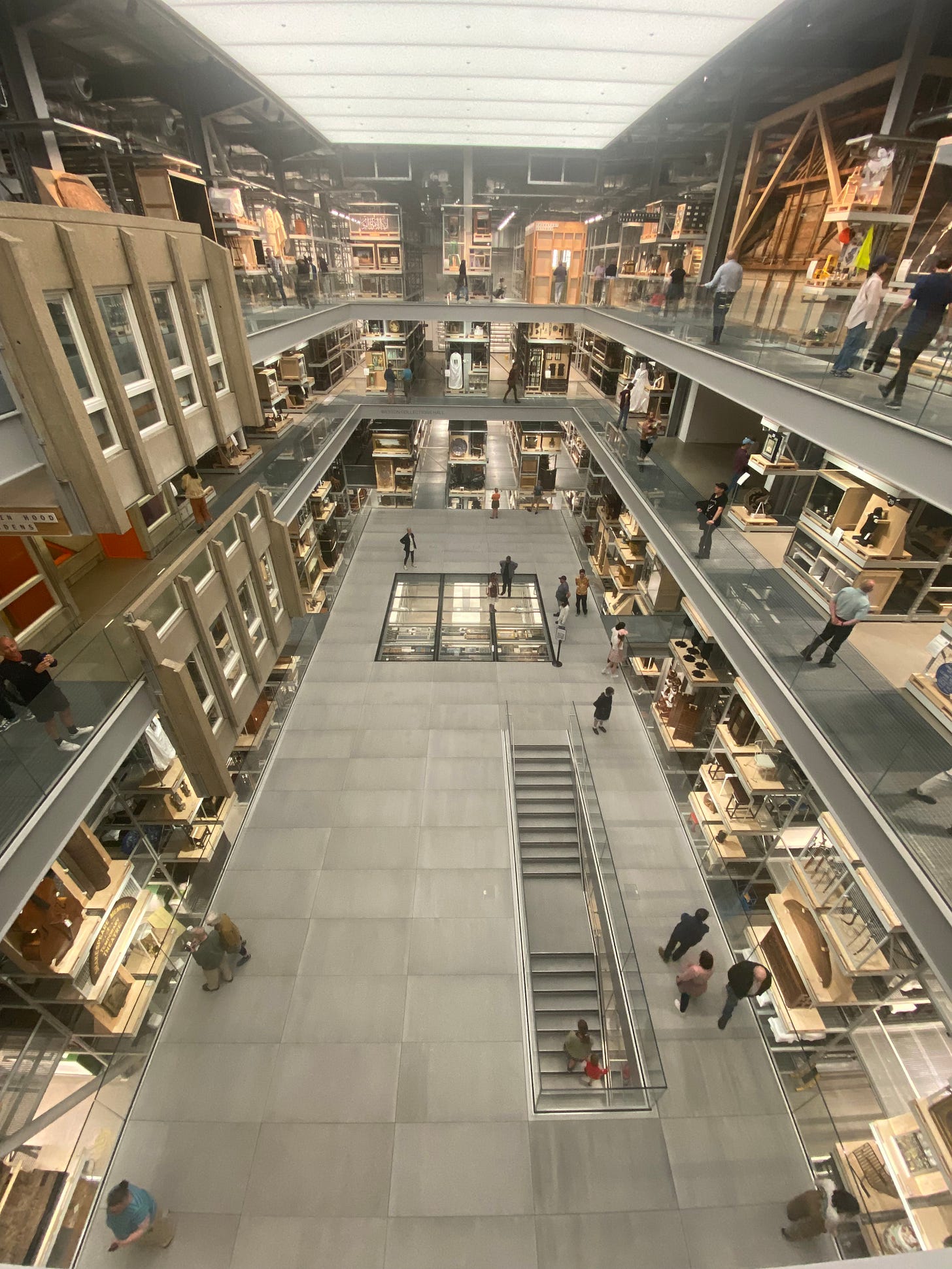No. 3: The V&A East Storehouse: On Transparency, Reckoning, and the Mechanics of Memory
Proof of Life Series: No. 3
A Reflection of the Times II: On Transparency, Reckoning, and the Mechanics of Memory
—On Visiting the V&A East Storehouse
If the Sir John Soane Museum represents a historical ideal—the individual collector as visionary, world-arranger, and authority—then the newly opened V&A East Storehouse reflects a different kind of architecture altogether: one of reckoning, humility, and systems laid bare.
Where Soane curated the world into a series of nested rooms, full of ornament, mystery, and power, the V&A East opens its drawers and says, Here’s how we’ve gathered what we gathered. Let’s begin again.
The Back of the House Comes Forward
Located in East London’s Queen Elizabeth Olympic Park, the V&A East Storehouse is not a museum in the traditional sense—it is an open archive, part visible storage facility, part working lab, part invitation to the public to witness the machinery of collection. Visitors don’t walk through period rooms or narrative galleries. They walk through process.
One sees racks of paintings still wrapped in plastic, drawers that slide open to reveal embroidery, jewelry, early plastics, architectural models. Conservators work in public view. Nothing is romanticized. Nothing is hidden.
This is collection as infrastructure, not theater.
And in this, the V&A East becomes a kind of self-exposure—a museum not just of objects but of its own inner logic. It does not pretend to purity. Instead, it says: This is what we inherited. This is how it was acquired. This is what we’re trying to understand.
The Reckoning Beneath the Transparency
But transparency is not neutral. The Storehouse is a response to history, a gesture toward accountability in the wake of ongoing cultural critique. It acknowledges the origins of its holdings—many of which were collected through colonial force, asymmetrical trade, or ethnographic reduction.
Here, the act of collecting is no longer innocent. Every object has a shadow. Provenance becomes not a footnote but the main subject. Who made it? Who lost it? Who took it? Why is it here?
There is no tidy answer. But the structure of the Storehouse itself makes space for the ongoing question. This is not curation as authority—it is curation as conversation.
Form Follows Function (and Memory)
Architecturally, the building is spare, honest, industrial. The materials—glass, steel, wood—carry no illusion. There is no marble to elevate. No velvet rope to separate. This is memory on the move. The archive is not sealed. It is under revision.
And perhaps that’s the most significant philosophical gesture: the Storehouse implies that collections are not complete, and may never be. That meaning is provisional. That access matters more than display. That the museum is no longer a vault—but a network of relationships, layered with past harms, present questions, and future invitations.
A Mirror for Other Models
For someone like me—working quietly for decades on the Ontological Museum, with no budget, no marble, no marble donors—the V&A East presents a curious counterpart. It has everything I don’t: a staff, a structure, institutional reach. But it also expresses a kind of institutional humility that feels newly aligned with the values many of us in the independent, mail art, Fluxus, collage, and asemic communities have long lived by: inclusivity, openness, process over product, transparency over permanence.
Of course, the V&A’s size still gives it enormous power—over narratives, visibility, resources. But it is attempting to decentralize that power, at least in part. It invites people not just to view objects, but to think with them. Not just to admire, but to ask, Why is this here? Who decides? And what’s missing?
The Storehouse as Portal
There’s a kind of paradox at the heart of the V&A East Storehouse: it is an archive of the past that gestures toward an ethical future. It’s a structure of accumulation that also signals the need to let go—of certainty, of supremacy, of the myth of cultural neutrality.
What it suggests is that museums of the future may not be monuments at all—but platforms, workshops, places for unfolding rather than conclusion.
It makes me think: the most meaningful museum today might not be the one that displays the most treasure, but the one that knows how to question itself.
In Dialogue with Soane—and with Us
Taken together, the Soane Museum and the V&A East Storehouse form a kind of dialogic frame: the former a product of empire’s certainty, the latter a structure seeking its accountability. One arranged the world to reflect a personal cosmology. The other disarranges the world to make space for new voices.
The Ontological Museum, by contrast, is not about collecting at all, in the institutional sense. It is about relation, resonance, and response. It doesn’t ask for permission. It doesn’t need a warehouse. It is a museum of gifted things, of traces, of shared presence. A museum that says: Here is what passed between us. Let’s keep that alive. Let’s remember.






Fabulous! Thanks for sharing this. It sounds like a place I could spend many hours and from which I could receive a lot of inspiration; things I would never have seen before or known existed. Maybe some day I can get there!